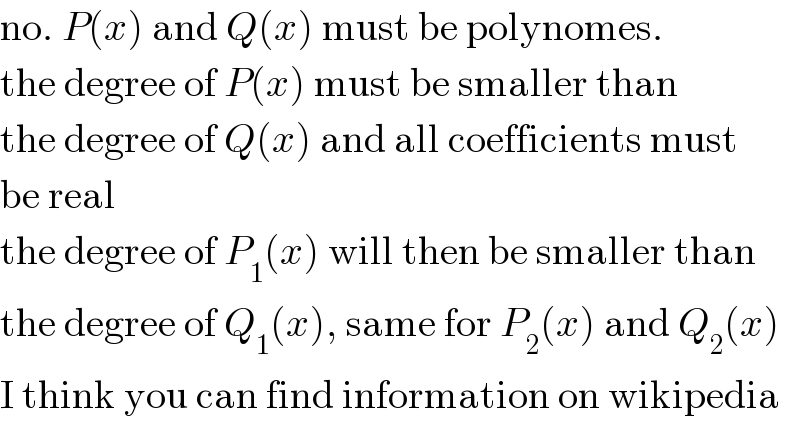
Question and Answers Forum
Question Number 81336 by mathmax by abdo last updated on 11/Feb/20

Commented by Tony Lin last updated on 12/Feb/20
![∫(dx/((x−1)^3 (x+3)^7 )) let u=((x+3)/(x−1)) , (du/dx)=((−4)/((x−1)^2 )) x=((u+3)/(u−1)) ⇒−(1/4)∫(du/(((4/(u−1)))(((4u)/(u−1)))^7 )) =−(1/4^9 )∫(((u−1)^8 )/u^7 )du =∫(u−8+((28)/u)−((56)/u^2 )+((70)/u^3 )−((56)/u^4 )+((28)/u^5 )−(8/u^6 )+(1/u^7 ))du ×(−(1/4^9 )) =((u^2 /2)−8u+28ln∣u∣+((56)/u)−((35)/u^2 )+((56)/(3u^3 ))−(7/u^4 ) +(8/(5u^5 ))−(1/(6u^(6 ) )))×(−(1/(262144)))+c plug u=((x+3)/(x−1)) in ⇒∫(dx/((x−1)^3 (x+3)^7 )) =−(1/(262144))[(((((x+3)/(x−1)))^2 )/2)−((8(x+3))/(x−1))+28ln∣((x+3)/(x−1))∣ +((56(x−1))/(x+3))−35(((x−1)/(x+3)))^2 +((56)/3)(((x−1)/(x+3)))^3 − 7(((x−1)/(x+3)))^4 +(8/5)(((x−1)/(x+3)))^5 −(1/6)(((x−1)/(x+3)))^6 ]+c](Q81361.png)
Commented by Tony Lin last updated on 12/Feb/20
![∫(dx/((x+a)^m (x+b)^n )) let u=((x+b)/(x+a)) , (du/dx)=((a−b)/((x+a)^2 )) x=((b−au)/(u−1)) ⇒(1/(a−b))∫(du/((((b−a)/(u−1)))^(m−2) [(((b−a)u)/(u−1))]^n )) =−(1/((b−a)^(m+n−1) ))∫ (((u−1)^(m+n−2) )/u^n )du =∫((Σ_(r=0) ^(m+n−2) C_r ^(m+n−2) (((x+b)/(x+a)))^(r−n) (−1)^(m+n−2−r) )/(−(b−a)^(m+n−1) ))d(((x+b)/(x+a)))](Q81363.png)
Commented by mathmax by abdo last updated on 12/Feb/20

Commented by MJS last updated on 12/Feb/20

Commented by mathmax by abdo last updated on 12/Feb/20

Commented by mathmax by abdo last updated on 12/Feb/20
![∫_2 ^(+∞) F(x)dx =−(1/(2.4^9 ))[(((x+3)/(x−1)))^2 ]_2 ^(+∞) +(8/4^9 )[(((x+3)/(x−1)))]_2 ^(+∞) +(C_8 ^2 /4^9 )[ln∣((x−1)/(x+3))∣]_2 ^(+∞) −(C_8 ^3 /4^9 )[(((x−1)/(x+3)))]_2 ^(+∞) +(C_8 ^4 /(2.4^9 ))[(((x−1)/(x+3)))^2 ]_2 ^(+∞) −(C_8 ^5 /(3.4^9 ))[(((x−1)/(x+3)))^3 ]_2 ^(+∞) +(C_8 ^6 /4^(10) )[(((x−1)/(x+3)))^4 ]_2 ^(+∞) −(C_8 ^7 /(5.4^9 ))[(((x−1)/(x+3)))^5 ]_2 ^(+∞) +(1/(6.4^9 ))[(((x−1)/(x+3)))^6 ]_2 ^(+∞) =−(1/(2.4^9 )){1−5^2 }+(8/4^9 ){1−5}+(C_8 ^2 /4^9 ){−ln((1/5))} −(C_8 ^3 /4^9 ){1−(1/5)}+(C_8 ^4 /(2.4^9 )){1−((1/5))^2 }−(C_8 ^5 /(3.4^9 )){1−((1/5))^3 } +(C_8 ^6 /4^(10) ){1−((1/5))^4 }−(C_8 ^7 /(5.4^9 )){1−((1/5))^5 } +(1/(6.4^9 )){1−((1/5))^6 }](Q81378.png)
Commented by mathmax by abdo last updated on 12/Feb/20

Answered by MJS last updated on 12/Feb/20
![Ostrogradski′s Method again (it′s faster in my opinion) ∫(dx/((x+3)^7 (x−1)^3 )) ∫((P(x))/(Q(x)))dx=((P_1 (x))/(Q_1 (x)))+∫((P_2 (x))/(Q_2 (x)))dx Q_1 (x)=gcd (Q(x), Q^′ (x))=(x+3)^6 (x−1)^2 oo Q_2 (x)=((Q(x))/(Q_1 (x)))=(x+3)(x−1) ((P(x))/(Q(x)))=(d/dx)[((P_1 (x))/(Q_1 (x)))]+((P_2 (x))/(Q_2 (x))) (1/((x+3)^7 (x−1)^3 ))=(d/dx)[((Σ_(j=0) ^7 c_j x^j )/((x+3)^6 (x−1)^2 ))]+((d_1 x+d_0 )/((x+3)(x−1))) ⇒ P_1 (x)=((105x^7 +1575x^6 +9065x^5 +23135x^4 +15491x^3 −38339x^2 −56405x+14653)/(245760)) P_2 (x)=(7/(16384)) ⇒ we only have to solve (7/(16384))∫(dx/((x+3)(x−1)))= =(7/(65536))ln ∣((x−1)/(x+3))∣ ∫(dx/((x+3)^7 (x−1)^3 ))= =((105x^7 +1575x^6 +9065x^5 +23135x^4 +15491x^3 −38339x^2 −56405x+14653)/(245760(x+3)^6 (x−1)^2 ))+(7/(65536))ln ∣((x−1)/(x+3))∣ +C ∫_2 ^∞ (dx/((x+3)^7 (x−1)^3 ))=((−517516+328125ln 5)/(3072000000))](Q81344.png)
Commented by john santu last updated on 12/Feb/20

Commented by msup trace by abdo last updated on 12/Feb/20

Commented by MJS last updated on 12/Feb/20

Commented by jagoll last updated on 12/Feb/20

